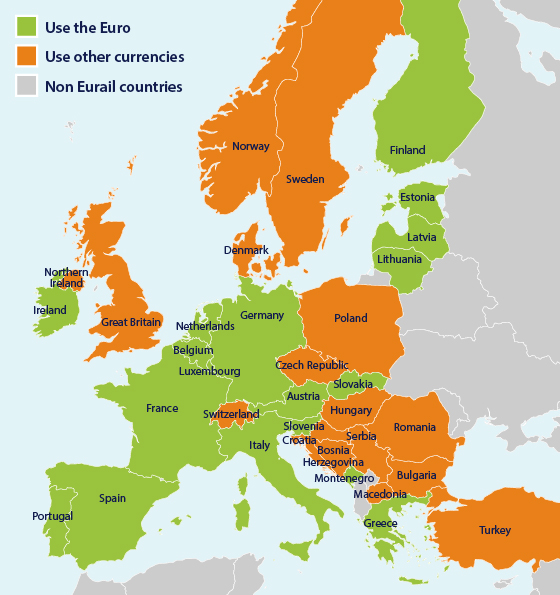There are 31 different european currencies used within the European continent. The most dominant amongst these currencies is the Euro as around 27 independent sovereign countries, as well as the dependent territories, use Euro as the legal tender. The Euro, the Swiss Franc, and the Pound sterling are the most widely used payment instruments in banking and international trade and are the ones included amongst the list of top 10 most traded currencies of the world in the Forex market. The currency of a nation is an important asset that fosters the exchange of goods and services across the world, Currencies in Europe. Currencies are inclusive of the coins as well as the banknotes that are utilized as a legal tender.
A total of about 31 currencies are used in 50 European countries which incorporate the 44 independent sovereign countries recognized by the UN and the other dependent territories. The most common of all the currencies used in Europe is Euro and any country that becomes a member of the European Union is expected to join the Eurozone. Denmark is the only country that has been exempted from using the Euro. On the other hand, Sweden is still left to adopt the Euro as currency as it is still to meet up with the Exchange Rate Mechanism II. About 19 of the 28 countries in the European Union along with five other non-European countries have the Euro as a legal tender. Some of the most widely used European currencies in addition to the Euro are inclusive of the Pound sterling, Krone and Krona currencies. Let us see more about these.
The Euro Currency
The Economic and Monetary project of the EU established in the year 2002 resulted in the adoption of the Euro currency. All the member countries of the European Union use the currency except for three i.e. Denmark, Sweden, and the UK. All the institutions of the European Union and the countries that aren’t members of the EU like the Republic of Kosovo use The Euro as their currency, Currencies in Europe. Around 200 million people outside the European Union make use of the currencies that are identical to the Euro. After the US Dollars, the Euro is the second largest currency reserve and also one amongst the most traded currencies across the world. The Euro was introduced to the world in the year 1999 and the name was officially adopted in December 1995 in Madrid. The currency is further divided into euro cents i.e. 100 cents. In support of the linguistic plurality, the Latin alphabet version is used. Alain Billiet from Belgium taking inspiration from the symbol that comes from the European civilization’s cradle created the euro sign.

Pound Sterling
The United Kingdom along with its other colonies and territories makes use of the currency called Pound Sterling. The pound sterling is also used as a currency in other states and countries such as Gibraltar, Falkland Island and the Isle of Man. The pound sterling has been in continuous usage since its inception and is one of the oldest currencies of the World. The issuance of pound sterling coins and banknotes is regulated by the Bank Of England. It is ranked as the fourth most traded currencies across the world after US Dollars, Euro and Japanese Yen. Backed by silver or gold to some point in time, pound sterling earlier was commodity money but as of now it has been backed by the country’s economy and is a legal tender there.
Krone And Krona Currencies
The name Krona and Krone have been given to the currencies that some of the European countries make use of. These two names refer to the crown in the English language. Denmark uses its official currency as Danish Krone which was introduced in the year 1875 and is pegged to the Euro. Similarly, Norwegian Krone is the currency used in Norway as well as its territories. Since 2012 this currency has existed only electronically. Krone or Krona is the world’s 13th most traded currency. The other countries using this currency include Iceland and Sweden.
Conclusion
The total number of european countries’ currency used by the European continent is 31 and out of this the most widely used currency here is the Euro, Currencies in Europe. The word currency is a Latin word and it represents money in any form in particular coins and banknotes for the exchange of goods and services. In the European continent, the Euro accounts for the maximum countries whilst others operate with their independent monetary policies.

